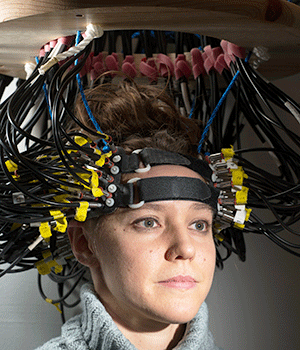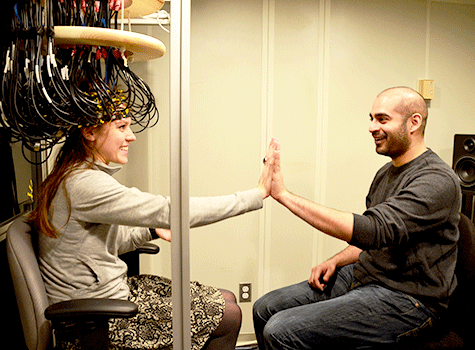Improved optical brain-scanning tech rivals fMRI and PET without the risks
May 28, 2014

Trendy neogeek hair style? No, a cap used to image the brain via diffuse optical tomography (credit: Tim Parker)
Washington University School of Medicine researchers have developed a new form of brain-scanning technology that improves on diffuse optical tomography (DOT).
The new technology now allows researchers to image brain processes taking place in multiple regions and brain networks such as those involved in language processing and self-reflection (daydreaming). DOT was previously limited to small regions of the brain.
DOT avoids the radiation exposure of positron emission tomography (PET) and the bulky magnets of functional magnetic resonance imaging (fMRI), both of which often disrupt the function or safety of implanted electrical devices.
The new optical approach to brain scanning is ideally suited for children and for patients with electronic implants, such as pacemakers, cochlear implants and deep brain stimulators (used to treat Parkinson’s disease).
“When the neuronal activity of a region in the brain increases, highly oxygenated blood flows to the parts of the brain doing more work, and we can detect that,” said senior author Joseph Culver, PhD, associate professor of radiology. “It’s roughly akin to spotting the rush of blood to someone’s cheeks when they blush.”
The technique works by detecting near-infrared light transmitted through the head and capturing the dynamic changes in the colors of the brain tissue.
Benefits over fMRI and PET
Although DOT technology now is used in research settings, it also has the potential to be helpful in many medical scenarios as a surrogate for functional MRI, the most commonly used imaging method for mapping human brain function. Functional MRI also tracks activity in the brain via changes in blood flow. In addition to greatly adding to our understanding of the human brain, fMRI is used to diagnose and monitor brain disease and therapy.

Research participants Britt Gott (left) and Sridhar Kandala demonstrate the ability to interact while being scanned via diffuse optical tomography. Patients in MRI scanners don’t have the same freedom to move and interact. (Credit: Mickey Wynn)
Another commonly used method for mapping brain function is positron emission tomography (PET), which involves radiation exposure. Because DOT technology does not use radiation, multiple scans performed over time could be used to monitor the progress of patients treated for brain injuries, developmental disorders such as autism, neurodegenerative disorders such as Parkinson’s, and other diseases.
Unlike fMRI and PET, DOT technology is designed to be portable, so it could be used at a patient’s bedside or in the operating room.
“With the new improvements in image quality, DOT is moving significantly closer to the resolution and positional accuracy of fMRI,” said first author Adam T. Eggebrecht, PhD, a postdoctoral research fellow. “That means DOT can be used as a stronger surrogate in situations where fMRI cannot be used.”
The researchers have many ideas for applying DOT, including learning more about how deep brain stimulation helps Parkinson’s patients, imaging the brain during social interactions, and studying what happens to the brain during general anesthesia and when the heart is temporarily stopped during cardiac surgery.
DOT vs. fMRI
The researchers note in their Nature Photonics paper:
Expanding the FOV [field of view] of HD [high density] arrays to cover a significant portion of the head presents significant challenges in high-channel-count instrumentation, light source encoding (separating signal detected from multiple sources), fibre-optic-scalp coupling, imaging array ergonomics, data quality management and anatomical light modelling algorithms. Here, we present a diffuse optical tomography imaging system that overcomes these technical challenges through integrative advances in optical instrumentation, fibre-optic cap design, optical data registration and light modelling.
For the current study, the researchers validated the performance of DOT by comparing its results to fMRI scans. Data was collected using the same subjects, and the DOT and fMRI images were aligned. They looked for Broca’s area, a key area of the frontal lobe used for language and speech production. The overlap between the brain region identified as Broca’s area by DOT data and by fMRI scans was about 75 percent.
In a second set of tests, researchers used DOT and fMRI to detect brain networks that are active when subjects are resting or daydreaming. Researchers’ interests in these networks have grown enormously over the past decade as the networks have been tied to many different aspects of brain health and sickness, such as schizophrenia, autism and Alzheimer’s disease. In these studies, the DOT data also showed remarkable similarity to fMRI — picking out the same cluster of three regions in both hemispheres.
“With the improved image quality of the new DOT system, we are getting much closer to the accuracy of fMRI,” Culver said. “We’ve achieved a level of detail that, going forward, could make optical neuroimaging much more useful in research and the clinic.”
Reliable data down to one centimeter of brain tissue
While DOT doesn’t let scientists peer very deeply into the brain, researchers can get reliable data to a depth of about one centimeter of tissue. That centimeter contains some of the brain’s most important and interesting areas with many higher brain functions, such as memory, language and self-awareness, represented.
During DOT scans, the subject wears a cap composed of many light sources and sensors connected to cables. The full-scale DOT unit takes up an area slightly larger than an old-fashioned phone booth, but Culver and his colleagues have built versions of the scanner mounted on wheeled carts. They continue to work to make the technology more portable.
Culver and Washington University have financial interests in Cephalogics LLC based on a license of related optical imaging technology by the university to Cephalogics LLC. They are regulated in accordance with the university’s conflict-of-interest policies.
The research is funded by the National Institutes of Health (NIH), an Autism Speaks Postdoctoral Translational Research Fellowship, a Fulbright Science and Technology PhD Award, and a McDonnell Centre for Systems Neuroscience grant.
Abstract of Nature Photonics paper
Mapping of human brain function has revolutionized systems neuroscience. However, traditional functional neuroimaging by positron emission tomography or functional magnetic resonance imaging cannot be used when applications require portability, or are contraindicated because of ionizing radiation (positron emission tomography) or implanted metal (functional magnetic resonance imaging). Optical neuroimaging offers a non-invasive alternative that is radiation free and compatible with implanted metal and electronic devices (for example, pacemakers). However, optical imaging technology has heretofore lacked the combination of spatial resolution and wide field of view sufficient to map distributed brain functions. Here, we present a high-density diffuse optical tomography imaging array that can map higher-order, distributed brain function. The system was tested by imaging four hierarchical language tasks and multiple resting-state networks including the dorsal attention and default mode networks. Finally, we imaged brain function in patients with Parkinson’s disease and implanted deep brain stimulators that preclude functional magnetic resonance imaging.
